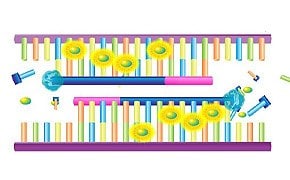Quantitative PCR (qPCR)

Bei der quantitativen Echtzeit-PCR (qPCR) werden fluoreszente Reportermoleküle eingesetzt, um die Quantifizierung der amplifizierten Produkte zu ermöglichen. Wie bei der konventionellen PCR wird ein DNA-, cDNA- oder RNA-Template amplifiziert, jedoch werden in jedem Zyklus Fluoreszenzsignale zur relativen oder absoluten Quantifizierung überwacht. Diese Methode ist für zahlreiche Forschungsbereiche nützlich, wie z.B. Genexpressionsanalyse, Genotypisierung, microRNA-Analyse, genetische Variationsanalyse und Proteinanalyse.
Analyse von qPCR-Daten
Die Fluoreszenz des Reportermoleküls wird gemessen und quantifiziert; üblicherweise handelt es sich dabei um Farbstoffe (z.B. SYBR® Green, Ethidiumbromid), die sich zwischen den Basen in doppelsträngiger DNA einlagern, oder um Sonden (z.B. Molecular Beacons, TaqMan® Sonden), die eine spezifische Sequenz auf der DNA binden.
Relative Quantifizierung von qPCR-Daten
Es gibt zwei wesentliche Quantifizierungsmethoden für qPCR-Daten. Die relative Quantifizierung ist die gebräuchlichere Methode und nutzt ΔΔCt-Informationen, anhand derer das Expressions- oder Abundanzverhältnis des Zielgens in der Probe bestimmt, mit einem Kontrollgen verglichen und mit dem Expressionsverhältnis eines Referenzgens normalisiert wird. Da die Effizienz(E)-Werte für Ziel- und Referenzgene unterschiedlich sind, berücksichtigt diese Methode auch die Unterschiede bei den E-Werten. Diese Methode wird häufiger bei der Genexpressionsanalyse eingesetzt.
Absolute Quantifizierung von qPCR-Daten
Die zweite Methode, die absolute Quantifizierung, ist in der Umweltmikrobiologie gebräuchlicher. In ihr wird die Standardkurve (SK) genutzt. Bei der SK-Methode wird anhand einer Verdünnungsreihe mit bekannter Templatekonzentration (N0) eine Standardkurve mithilfe der linearen Regression von log(N0) gegenüber dem CT-Wert (Schwellenwert) erstellt. Daraus werden dann die Templatekonzentrationen der Probe berechnet. Dieser Methode liegt zugrunde, dass der Effizienzwert der Probe und der Effizienzwert des Standards gleich sind.
Zugehörige technische Artikel
- After a traditional PCR has been completed, the PCR/qPCR data analysis is conducted by resolution through an agarose gel or, more recently, through a capillary.
- Real-time polymerase chain reaction allows researchers to estimate the quantity of starting material in a sample. It has a much wider dynamic range of analysis than conventional PCR
- PCR assay guide navigates you through primer validation and other assay optimization factors to ensure high sensitivity and specificity for optimum DNA/ RNA quantification.
- The entire PCR workflow is vulnerable to factors which introduce variability. Many of the variable components are unavoidable, such as the source of the sample or the requirement for a reverse transcription step. Assay design is also highly variable and can make the difference between PCR success and failure and also contributes to the reproducibility and sensitivity of an assay.
- Dual-Labeled Probes are the most common probe type for qPCR and are often referred to as hydrolysis probes.
- Alle anzeigen (39)
Zugehörige Protokolle
- Our SYBR Green qPCR Protocol is a method designed to detect accurate quantification of gene expression and RT-PCR reactions
- Chromatin Immunoprecipitation quantitative real-time PCR (ChIP-qPCR) is commonly used in studies that focus on specific genes and potential regulatory regions across differing experimental conditions and data analysis. qPCR enables DNA analysis in real time by analyzing fluorescent signal intensities that are proportional to the amount of amplicon.
- Primer Concentration Optimization Protocol is an approach to create a matrix of reactions. This is used to test a range of concentrations for each primer against different concentrations of the partner primer.
- Optimization of qPCR conditions is important for the development of a robust assay. The two main approaches are optimization of primer concentration and/or annealing temperatures.
- Multiplex qPCR employing probe-based chemistries is a demanding application that often requires extensive optimization and validation.
- Alle anzeigen (32)
Um weiterzulesen, melden Sie sich bitte an oder erstellen ein Konto.
Sie haben kein Konto?